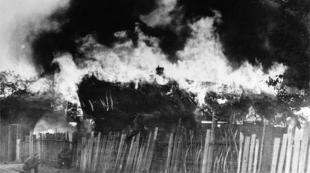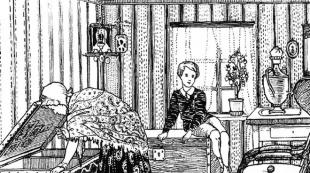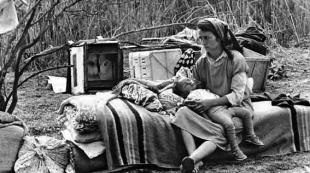Prehistory of the conflict in Nagorno-Karabakh. Nagorno-Karabakh: causes of the conflict. Azerbaijani Defense Minister is a protege of Turkey
Nagorno-Karabakh (Armenians prefer to use the old name Artsakh) is a small territory in the Transcaucasus. Mountains cut by deep gorges, turning into valleys in the east, small fast rivers, forests below and steppes higher up the mountain slopes, a cool climate without sudden changes in temperature. From ancient times, this territory was inhabited by Armenians, was part of various Armenian states and principalities, and numerous monuments of Armenian history and culture are located on its territory.
At the same time, a significant Turkic population has been penetrating here since the 18th century (the term "Azerbaijanis" was not yet accepted), the territory is part of the Karabakh Khanate, which was ruled by a Turkic dynasty, and the majority of the population of which were Muslim Turks.
In the first half of the 19th century, as a result of wars with Turkey, Persia and individual khanates, the entire Transcaucasus, including Nagorno-Karabakh, goes to Russia. Somewhat later, it was divided into provinces without regard to ethnicity. So Nagorno-Karabakh at the beginning of the 20th century was part of the Elizavetpol province, most of which was inhabited by Azerbaijanis.
By 1918, the Russian Empire had disintegrated as a result of well-known revolutionary events. Transcaucasia became the arena of bloody inter-ethnic struggle, until the time it was held back by the Russian authorities (It is worth noting that during the previous weakening of imperial power during the revolution of 1905-1907, Karabakh already became the scene of clashes between Armenians and Azerbaijanis.). The newly formed state of Azerbaijan claimed the entire territory of the former Elizavetpol province. The Armenians, who constituted the majority in Nagorno-Karabakh, wished either to be independent or to join the Armenian Republic. The situation was accompanied by military clashes. Even when both states, Armenia and Azerbaijan, became Soviet republics, a territorial dispute continued between them. It was decided in favor of Azerbaijan, but with reservations: most of the territories with the Armenian population were allocated to the Nagorno-Karabakh Autonomous Region (NKAR) as part of the Azerbaijan SSR. The reasons why the Union leadership made such a decision are unclear. Turkey’s influence (in favor of Azerbaijan), the greater influence of the Azerbaijani “lobby” in the union leadership compared to the Armenian one, Moscow’s desire to maintain a hotbed of tension in order to act as the supreme arbiter, etc. are put forward as assumptions.
In Soviet times, the conflict quietly smoldered, breaking through either with the petitions of the Armenian public for the transfer of Nagorno-Karabakh to Armenia, or with the measures of the Azerbaijani leadership to creep out the Armenian population from the regions adjacent to the autonomous region. The abscess broke through as soon as the allied power weakened during the "perestroika".
The conflict in Nagorno-Karabakh became a landmark for the Soviet Union. He clearly showed the growing helplessness of the central leadership. He demonstrated for the first time that the Union, which seemed indestructible in accordance with the words of his anthem, can be destroyed. In some way, it was the Nagorno-Karabakh conflict that became the catalyst for the process of the collapse of the Soviet Union. Thus, its significance goes far beyond the region. It is difficult to say which way the history of the USSR, and hence the whole world, would have gone if Moscow had found the strength to quickly resolve this dispute.
The conflict began in 1987 with mass rallies of the Armenian population under the slogans of reunification with Armenia. The Azerbaijani leadership, with the support of the Union, unambiguously rejects these demands. Attempts to resolve the situation are reduced to holding meetings and issuing documents. In the same year, the first Azerbaijani refugees from Nagorno-Karabakh appear. In 1988, the first blood was shed - two Azerbaijanis died in a clash with Armenians and police in the village of Askeran. Information about this incident leads to an Armenian pogrom in Azerbaijani Sumgayit. This is the first mass ethnic violence in the Soviet Union in decades and the first death bell toll on Soviet unity. Further violence grows, the flow of refugees from both sides increases. The central government demonstrates helplessness, the adoption of real decisions is at the mercy of the republican authorities. The actions of the latter (the deportation of the Armenian population and the economic blockade of Nagorno-Karabakh by Azerbaijan, the proclamation of Nagorno-Karabakh as part of the Armenian SSR by Armenia) inflame the situation.

Azerbaijani refugees from the region of the Nagorno-Karabakh conflict, 1993.
Since 1990, the conflict has escalated into a war with the use of artillery. Illegal armed formations are active. The leadership of the USSR is trying to use force (mainly against the Armenian side), but it's too late - the Soviet Union itself ceases to exist. Independent Azerbaijan proclaims Nagorno-Karabakh as its part. The NKAR declares independence within the boundaries of the autonomous region and the Shahumyan region of the Azerbaijan SSR.
The war lasted until 1994, accompanied by war crimes and heavy civilian casualties on both sides. Many cities were turned into ruins. On the one hand, the armies of Nagorno-Karabakh and Armenia participated in it, on the other hand, the armies of Azerbaijan, with the support of Muslim volunteers from around the world (usually they mention Afghan Mujahideen and Chechen fighters). The war ended after the decisive victories of the Armenian side, which established control over most of Nagorno-Karabakh and the adjacent regions of Azerbaijan. After that, the parties agreed to the mediation of the CIS (primarily Russia). Since then, a fragile peace has been maintained in Nagorno-Karabakh, sometimes broken by skirmishes on the border.
The war is over, but the problem is far from being solved.
Azerbaijan firmly insists on its territorial integrity, agreeing to discuss only the autonomy of the republic. The Armenian side just as firmly insists on the independence of Karabakh. The main obstacle to constructive negotiations is the mutual exasperation of the parties. By setting the peoples against each other (or at least not preventing the incitement of hatred), the authorities fell into a trap - now it is impossible for them to take a step towards the other side without being accused of betrayal.

The fourth building of the sanatorium "Shusha". In this building in 1988 the regiment 3217 VV was located to ensure order and peace in Nagorno-Karabakh.
The depth of the abyss between the peoples is well seen in the coverage of the conflict by both sides. There is no hint of objectivity. The parties unanimously keep silent about unfavorable pages of history for themselves and immensely inflate the crimes of the enemy.
The Armenian side focuses on the historical belonging of the region of Armenia, on the illegality of the inclusion of Nagorno-Karabakh in the Azerbaijan SSR, on the right of peoples to self-determination. The crimes of Azerbaijanis against the civilian population are depicted - such as pogroms in Sumgayit, Baku, etc. At the same time, real events acquire clearly exaggerated features - such as the story of mass cannibalism in Sumgayit. Azerbaijan's connection with international Islamic terrorism is being raised. From the conflict, the accusations are transferred to the structure of the Azerbaijani state in general.
The Azerbaijani side, in turn, rests on the long-standing ties between Karabakh and Azerbaijan (remembering the Turkic Karabakh Khanate), on the principle of inviolability of borders. The crimes of Armenian militants are also commemorated, while their own are completely forgotten. The connection of Armenia with the international Armenian terrorism is pointed out. Unflattering conclusions are drawn about the world Armenians as a whole.
In such an environment, it is extremely difficult for international mediators to act, especially given the fact that the mediators themselves represent different world forces and act in different interests.
The main international group trying to resolve the conflict is the so-called OSCE Minsk Group chaired by Russia, France and the United States.
In general, the group offered a choice of three settlement plans - a package, a staged plan and a comprehensive settlement plan based on the concept of a "common state". According to the latter, "Nagorno-Karabakh is a state and territorial entity in the form of a Republic and forms a common state with Azerbaijan within its internationally recognized borders" (Quoted by Jilavyan A. "Karabakh boom." // "Nezavisimaya Gazeta" dated 23.02.2003). Nagorno-Karabakh was supposed to be granted broad autonomy, including the right to direct foreign economic activity, the right to security forces (in fact, the army), its own constitution and the issuance of its own banknotes. The borders of the republic were established within the NKAO, the border between Nagorno-Karabakh and Azerbaijan was declared open. The budget of Karabakh was to be formed from its own sources.
Such autonomy suspiciously resembled independence, and Azerbaijan rejected the plan, while Armenia and the NKR accepted it.
The United States proposed its plan in 2006 in the person of OSCE Minsk Group co-chairman Matthew Bryza. It was based on the following principles:
Armenian forces are leaving the occupied Azerbaijani territories outside the former NKAO;
Diplomatic relations between Armenia and Azerbaijan are being normalized;
These territories host international peacekeeping forces;
A referendum on independence is being held on the territory of Nagorno-Karabakh.
Despite the apparent profitability, this plan has already raised many questions from the Armenian side.
Firstly, the occupied regions create a "security belt" around the NKR. They have strategically important heights that allow shooting through the territory of the unrecognized republic.
Secondly, the territory of the Lachin and Kelbajar regions, which the Armenians must also leave according to Bryza's plan, is wedged between Nagorno-Karabakh and Armenia. By handing them over, the Karabakh Armenians run the risk of being surrounded.
Thirdly, Armenia stimulated resettlement in the territories of these two regions. What about the migrants?
Fourthly, the Armenians are interested in the composition of the peacekeeping forces and their real ability to keep the parties from violence.
The Azerbaijanis are not satisfied with the lack of an obligation to return refugees in the plan, as well as the ambiguity in holding a referendum - will the votes of the Azerbaijanis who left Karabakh as a result of the conflict be taken into account?
Thus, this plan also failed to reconcile the parties.
Several times the leaders of Armenia and Azerbaijan met face to face to discuss the problem. This was the case in 2001 in Paris, and then in Key West (USA) and in 2006 in Paris (Château de Rambouillet). But even in these cases, no agreements could be reached.
Recently, there has been renewed hope for progress in resolving the conflict. Analysts attribute the increased activity of the parties to the Five-Day War in South Ossetia, which changed the balance of power in the Caucasus (especially the role of Russia) and clearly demonstrated how "frozen" conflicts could end. Since the end of 2008, Russia has been taking steps to bring the parties to the negotiating table. In November, Russia managed to achieve the signing of the Declaration on the non-use of force at the talks in the Moscow region. The document states the readiness of the parties "to contribute to the improvement of the situation in the South Caucasus and the establishment of an environment of stability and security in the region through a political settlement of the Nagorno-Karabakh conflict on the principles and norms of international law" . An agreement was also reached to hold direct talks between the presidents of Armenia and Azerbaijan in June 2009. Another regional player is also active - Turkey, which previously acted from an extremely pro-Azerbaijani position. Last year, Turkey made some contacts with the Armenian side for the first time.
Celebration of the 20th anniversary of the Independence Day of the Nagorno-Karabakh Republic / Leadership of Nagorno-Karabakh, Armenia, clergy. September 2, 2011
At the same time, the parties declare their determination to defend their principled positions - the integrity of Azerbaijan and the independence of Nagorno-Karabakh, respectively. Given the incompatibility of these positions, it is not very clear what the presidents will talk about in June. Perhaps this conflict will be resolved only when generations change and the intensity of hatred between peoples weakens.
The conflict between Azerbaijan, on the one hand, and Armenia and the NKR, on the other, escalated on April 2, 2016: the parties accused each other of shelling the border areas, after which positional battles began. At least 33 people were killed in the fighting, according to the UN.
Nagorno-Karabakh (Armenians prefer to use the old name Artsakh) is a small territory in the Transcaucasus. Mountains cut by deep gorges, turning into valleys in the east, small fast rivers, forests below and steppes higher up the mountain slopes, a cool climate without sudden changes in temperature. From ancient times, this territory was inhabited by Armenians, was part of various Armenian states and principalities, and numerous monuments of Armenian history and culture are located on its territory.
At the same time, a significant Turkic population has been penetrating here since the 18th century (the term "Azerbaijanis" was not yet accepted), the territory is part of the Karabakh Khanate, which was ruled by a Turkic dynasty, and the majority of the population of which were Muslim Turks.
In the first half of the 19th century, as a result of wars with Turkey, Persia and individual khanates, the entire Transcaucasus, including Nagorno-Karabakh, goes to Russia. Somewhat later, it was divided into provinces without regard to ethnicity. So Nagorno-Karabakh at the beginning of the 20th century was part of the Elizavetpol province, most of which was inhabited by Azerbaijanis.
By 1918, the Russian Empire had disintegrated as a result of well-known revolutionary events. Transcaucasia became the arena of bloody inter-ethnic struggle, until the time restrained by the Russian authorities (It is worth noting that during the previous weakening of imperial power during the revolution of 1905-1907, Karabakh already became the arena of clashes between Armenians and Azerbaijanis.). The newly formed state of Azerbaijan claimed the entire territory of the former Elizavetpol province.
The Armenians, who constituted the majority in Nagorno-Karabakh, wished either to be independent or to join the Armenian Republic. The situation was accompanied by military clashes. Even when both states, Armenia and Azerbaijan, became Soviet republics, a territorial dispute continued between them. It was decided in favor of Azerbaijan, but with reservations: most of the territories with the Armenian population were allocated to the Nagorno-Karabakh Autonomous Region (NKAR) as part of the Azerbaijan SSR.
The reasons why the Union leadership made such a decision are unclear. Turkey’s influence (in favor of Azerbaijan), the greater influence of the Azerbaijani “lobby” in the union leadership compared to the Armenian one, Moscow’s desire to maintain a hotbed of tension in order to act as the supreme arbiter, etc. are put forward as assumptions.
In Soviet times, the conflict quietly smoldered, breaking through either with the petitions of the Armenian public for the transfer of Nagorno-Karabakh to Armenia, or with the measures of the Azerbaijani leadership to creep out the Armenian population from the regions adjacent to the autonomous region. The abscess broke through as soon as the allied power weakened during the "perestroika".
The conflict in Nagorno-Karabakh became a landmark for the Soviet Union. He clearly showed the growing helplessness of the central leadership. He demonstrated for the first time that the Union, which seemed indestructible in accordance with the words of his anthem, can be destroyed. In some way, it was the Nagorno-Karabakh conflict that became the catalyst for the process of the collapse of the Soviet Union. Thus, its significance goes far beyond the region. It is difficult to say which way the history of the USSR, and hence the whole world, would have gone if Moscow had found the strength to quickly resolve this dispute.
The conflict began in 1987 with mass rallies of the Armenian population under the slogans of reunification with Armenia. The Azerbaijani leadership, with the support of the Union, unambiguously rejects these demands. Attempts to resolve the situation are reduced to holding meetings and issuing documents.
In the same year, the first Azerbaijani refugees from Nagorno-Karabakh appear. In 1988, the first blood was shed - two Azerbaijanis died in a clash with Armenians and police in the village of Askeran. Information about this incident leads to an Armenian pogrom in Azerbaijani Sumgayit. This is the first case of mass ethnic violence in the Soviet Union in several decades and the first death bell toll on Soviet unity. Further violence grows, the flow of refugees from both sides increases. The central government demonstrates helplessness, the adoption of real decisions is at the mercy of the republican authorities. The actions of the latter (the deportation of the Armenian population and the economic blockade of Nagorno-Karabakh by Azerbaijan, the proclamation of Nagorno-Karabakh as part of the Armenian SSR by Armenia) inflame the situation.
Since 1990, the conflict has escalated into a war with the use of artillery. Illegal armed formations are active. The leadership of the USSR is trying to use force (mainly against the Armenian side), but it's too late - the Soviet Union itself ceases to exist. Independent Azerbaijan proclaims Nagorno-Karabakh as its part. The NKAR declares independence within the boundaries of the autonomous region and the Shahumyan region of the Azerbaijan SSR.
The war lasted until 1994, accompanied by war crimes and heavy civilian casualties on both sides. Many cities were turned into ruins. On the one hand, the armies of Nagorno-Karabakh and Armenia took part in it, on the other, the armies of Azerbaijan, with the support of Muslim volunteers from around the world (usually they mention Afghan Mujahideen and Chechen fighters). The war ended after the decisive victories of the Armenian side, which established control over most of Nagorno-Karabakh and the adjacent regions of Azerbaijan. After that, the parties agreed to the mediation of the CIS (primarily Russia). Since then, a fragile peace has been maintained in Nagorno-Karabakh, sometimes broken by skirmishes on the border, but the problem is far from being solved.
Azerbaijan firmly insists on its territorial integrity, agreeing to discuss only the autonomy of the republic. The Armenian side just as firmly insists on the independence of Karabakh. The main obstacle to constructive negotiations is the mutual exasperation of the parties. By setting the peoples against each other (or at least not preventing the incitement of hatred), the authorities fell into a trap - now it is impossible for them to take a step towards the other side without being accused of betrayal.
The depth of the abyss between the peoples is well seen in the coverage of the conflict by both sides. There is no hint of objectivity. The parties unanimously keep silent about unfavorable pages of history for themselves and immensely inflate the crimes of the enemy.
The Armenian side focuses on the historical belonging of the region of Armenia, on the illegality of the inclusion of Nagorno-Karabakh in the Azerbaijan SSR, on the right of peoples to self-determination. The crimes of Azerbaijanis against the civilian population are depicted - such as pogroms in Sumgayit, Baku, etc. At the same time, real events acquire clearly exaggerated features - such as the story of mass cannibalism in Sumgayit. Azerbaijan's connection with international Islamic terrorism is being raised. From the conflict, the accusations are transferred to the structure of the Azerbaijani state in general.
The Azerbaijani side, in turn, rests on the long-standing ties between Karabakh and Azerbaijan (remembering the Turkic Karabakh Khanate), on the principle of inviolability of borders. The crimes of Armenian militants are also commemorated, while their own are completely forgotten. The connection of Armenia with the international Armenian terrorism is pointed out. Unflattering conclusions are drawn about the world Armenians as a whole.
In such an environment, it is extremely difficult for international mediators to act, especially given the fact that the mediators themselves represent different world forces and act in different interests.
The parties declare their determination to uphold the principled positions - the integrity of Azerbaijan and the independence of Nagorno-Karabakh, respectively. Perhaps this conflict will be resolved only when generations change and the intensity of hatred between peoples weakens.
15 years ago (1994) Azerbaijan, Nagorno-Karabakh and Armenia signed the Bishkek Protocol on ceasefire on May 12, 1994 in the Karabakh conflict zone.
Nagorno-Karabakh is a region in Transcaucasia, de jure part of Azerbaijan. The population is 138 thousand people, the vast majority are Armenians. The capital is the city of Stepanakert. The population is about 50 thousand people.
According to Armenian open sources, Nagorno-Karabakh (the ancient Armenian name is Artsakh) was first mentioned in the inscription of Sardur II, king of Urartu (763-734 BC). In the early Middle Ages, Nagorno-Karabakh was part of Armenia, according to Armenian sources. After most of this country was captured by Turkey and Iran in the Middle Ages, the Armenian principalities (melikdoms) of Nagorno-Karabakh retained a semi-independent status.
According to Azerbaijani sources, Karabakh is one of the most ancient historical regions of Azerbaijan. According to the official version, the appearance of the term "Karabakh" dates back to the 7th century and is interpreted as a combination of the Azerbaijani words "gara" (black) and "bag" (garden). Among other provinces of Karabakh (Ganja in Azerbaijani terminology) in the 16th century. was part of the Safavid state, later became an independent Karabakh khanate.
According to the Kurekchay Treaty of 1805, the Karabakh Khanate, as a Muslim-Azerbaijani land, was subordinated to Russia. V 1813 Under the Gulistan Peace Treaty, Nagorno-Karabakh became part of Russia. In the first third of the 19th century, according to the Treaty of Turkmenchay and the Treaty of Edirne, the artificial placement of Armenians resettled from Iran and Turkey began in Northern Azerbaijan, including in Karabakh.
On May 28, 1918, the independent state of the Azerbaijan Democratic Republic (ADR) was created in Northern Azerbaijan, which retained its political power over Karabakh. At the same time, the declared Armenian (Ararat) Republic put forward its claims to Karabakh, which were not recognized by the government of the ADR. In January 1919, the ADR government created the Karabakh province, which included the Shusha, Javanshir, Jabrayil and Zangezur districts.
V July 1921 By decision of the Caucasian Bureau of the Central Committee of the RCP (b), Nagorno-Karabakh was included in the Azerbaijan SSR on the basis of broad autonomy. In 1923, the Nagorno-Karabakh Autonomous Region was formed on the territory of Nagorno-Karabakh as part of Azerbaijan.
February 20, 1988 Extraordinary session of the Regional Council of Deputies of the NKAR adopted a decision "On the petition to the Supreme Soviets of the AzSSR and the ArmSSR for the transfer of the NKAO from the AzSSR to the ArmSSR". The refusal of the allied and Azerbaijani authorities caused demonstrations of protest by Armenians not only in Nagorno-Karabakh, but also in Yerevan.
On September 2, 1991, a joint session of the Nagorno-Karabakh regional and Shahumyan regional councils was held in Stepanakert. The session adopted a Declaration on the proclamation of the Nagorno-Karabakh Republic within the borders of the Nagorno-Karabakh Autonomous Region, the Shahumyan region and part of the Khanlar region of the former Azerbaijan SSR.
December 10, 1991, a few days before the official collapse of the Soviet Union, a referendum was held in Nagorno-Karabakh, in which the vast majority of the population - 99.89% - voted for complete independence from Azerbaijan.
Official Baku recognized this act as illegal and abolished the autonomy of Karabakh that existed in the Soviet years. Following this, an armed conflict began, during which Azerbaijan tried to keep Karabakh, and the Armenian detachments defended the independence of the region with the support of Yerevan and the Armenian diaspora from other countries.
During the conflict, regular Armenian units completely or partially captured seven regions that Azerbaijan considered its own. As a result, Azerbaijan lost control over Nagorno-Karabakh.
At the same time, the Armenian side believes that part of Karabakh remains under the control of Azerbaijan - the villages of Mardakert and Martuni regions, the entire Shaumyan region and the Getashen sub-region, as well as Nakhichevan.
In the description of the conflict, the parties give their own figures on losses, which differ from those of the opposite side. According to consolidated data, the losses of both sides during the Karabakh conflict amounted to 15 to 25 thousand people killed, more than 25 thousand wounded, hundreds of thousands of civilians left their places of residence.
May 5, 1994 Through the mediation of Russia, Kyrgyzstan and the CIS Inter-Parliamentary Assembly in Bishkek, the capital of Kyrgyzstan, Azerbaijan, Nagorno-Karabakh and Armenia signed a protocol that went down in the history of the settlement of the Karabakh conflict as Bishkek, on the basis of which an agreement on a ceasefire was reached on May 12.
On May 12 of the same year, a meeting was held in Moscow between the Minister of Defense of Armenia Serzh Sargsyan (now the President of Armenia), the Minister of Defense of Azerbaijan Mammadraffi Mammadov and the commander of the NKR Defense Army Samvel Babayan, at which the commitment of the parties to the previously reached ceasefire agreement was confirmed.
The negotiation process to resolve the conflict began in 1991. September 23, 1991 A meeting of the Presidents of Russia, Kazakhstan, Azerbaijan and Armenia took place in Zheleznovodsk. In March 1992, the Minsk Group of the Organization for Security and Cooperation in Europe (OSCE) was established to resolve the Karabakh conflict, co-chaired by the United States, Russia and France. In mid-September 1993, the first meeting of representatives of Azerbaijan and Nagorno-Karabakh took place in Moscow. At about the same time, a private meeting was held in Moscow between Azerbaijani President Heydar Aliyev and then-Prime Minister of Nagorno-Karabakh Robert Kocharyan. Since 1999, regular meetings have been held between the presidents of Azerbaijan and Armenia.
Azerbaijan insists on maintaining its territorial integrity, Armenia defends the interests of the unrecognized republic, since the unrecognized NKR is not a party to the negotiations.
Where is Nagorno-Karabakh located?
Nagorno-Karabakh is a disputed region on the border between Armenia and Azerbaijan. The self-proclaimed Nagorno-Karabakh Republic was founded on September 2, 1991. The population is estimated in 2013 to be over 146,000. The vast majority of believers are Christians. The capital and largest city is Stepanakert.
What started the confrontation?
At the beginning of the 20th century, mainly Armenians lived in the region. It was then that this area became the site of bloody Armenian-Azerbaijani clashes. In 1917, due to the revolution and the collapse of the Russian Empire, three independent states were proclaimed in Transcaucasia, including the Republic of Azerbaijan, which included the Karabakh region. However, the Armenian population of the region refused to obey the new authorities. In the same year, the First Congress of the Armenians of Karabakh elected its own government - the Armenian National Council.
The conflict between the parties continued until the establishment of Soviet power in Azerbaijan. In 1920, Azerbaijani troops occupied the territory of Karabakh, but after a couple of months, the resistance of the Armenian armed groups was crushed thanks to the Soviet troops.
In 1920, the population of Nagorno-Karabakh was granted the right to self-determination, but de jure the territory continued to submit to the authorities of Azerbaijan. Since that time, not only riots, but also armed clashes have periodically flared up in the region.
How and when was the self-proclaimed republic created?
In 1987, the dissatisfaction with the socio-economic policy on the part of the Armenian population increased sharply. The measures taken by the leadership of the Azerbaijan SSR did not affect the situation. Mass strikes of students began, and thousands of nationalist rallies were held in the large city of Stepanakert.
Many Azerbaijanis, having assessed the situation, decided to leave the country. On the other hand, Armenian pogroms began to take place everywhere in Azerbaijan, as a result of which a huge number of refugees appeared.

Photo: TASS
The regional council of Nagorno-Karabakh decided to withdraw from Azerbaijan. In 1988, an armed conflict began between Armenians and Azerbaijanis. The territory got out of Azerbaijan's control, but the decision on its status was postponed indefinitely.
In 1991, hostilities began in the region with numerous losses on both sides. Agreements on a complete ceasefire and settlement of the situation were reached only in 1994 with the help of Russia, Kyrgyzstan and the CIS Interparliamentary Assembly in Bishkek.
Read all materials on the topic
When did the conflict escalate?
It should be noted that relatively recently the long-term conflict in Nagorno-Karabakh again reminded of itself. This happened in August 2014. Then skirmishes on the Armenian-Azerbaijani border took place between the military of the two countries. More than 20 people died on both sides.
What is happening now in Nagorno-Karabakh?
On the night of April 2, it happened. The Armenian and Azerbaijani sides blame each other for its escalation.
The Azerbaijani Defense Ministry announces shelling by the Armenian armed forces using mortars and heavy machine guns. It is alleged that over the past day, the Armenian military violated the ceasefire 127 times.
In turn, the Armenian military department says that the Azerbaijani side undertook "active offensive operations" on the night of April 2 using tanks, artillery and aircraft.

Are there any victims?
Yes, I have. However, their data differ. According to the official version of the UN Office for the Coordination of Humanitarian Affairs, over 200 were injured.
UN OCHA:“According to official sources in Armenia and Azerbaijan, at least 30 soldiers and 3 civilians have died as a result of the fighting. The number of wounded, both civilian and military, has not yet been officially confirmed. According to unofficial sources, more than 200 people were injured.”
How did the authorities and public organizations react to this situation?
The Russian Foreign Ministry maintains constant contact with the leadership of the foreign ministries of Azerbaijan and Armenia. and Maria Zakharova called on the parties to end the violence in Nagorno-Karabakh. According to Russian Foreign Ministry spokeswoman Maria Zakharova, reports of a serious
It should be noted that it remains the most stressful. , Yerevan refuted these statements and called them a trick. Baku denies these accusations and speaks of provocations by Armenia. Azerbaijani President Aliyev convened the country's Security Council, which was broadcast on national television.
The appeal of the PACE President to the parties to the conflict with an appeal to refrain from the use of violence and resume negotiations on a peaceful settlement has already been published on the organization's website.
A similar call was made by the International Committee of the Red Cross. He convinces Yerevan and Baku to protect the civilian population. Also, the committee's employees say they are ready to become mediators in the negotiations between Armenia and Azerbaijan.
A military clash arose here, since the vast majority of the inhabitants inhabiting the territory have Armenian roots. The essence of the conflict is that Azerbaijan makes quite reasonable demands on this territory, however, the inhabitants of the region gravitate more towards Armenia. On May 12, 1994, Azerbaijan, Armenia and Nagorno-Karabakh ratified a protocol that established a truce, which resulted in an unconditional ceasefire in the conflict zone.
Excursion into history
Armenian historical sources claim that Artsakh (the ancient Armenian name) was first mentioned in the 8th century BC. According to these sources, Nagorno-Karabakh was part of Armenia in the early Middle Ages. As a result of the aggressive wars of Turkey and Iran in this era, a significant part of Armenia came under the control of these countries. The Armenian principalities, or melikdoms, at that time located on the territory of modern Karabakh, retained a semi-independent status.
Azerbaijan has its own point of view on this issue. According to local researchers, Karabakh is one of the most ancient historical regions of their country. The word “Karabakh” in Azerbaijani is translated as follows: “gara” means black, and “bag” means garden. Already in the 16th century, together with other provinces, Karabakh was part of the Safavid state, and after that it became an independent khanate.
Nagorno-Karabakh during the Russian Empire
In 1805, the Karabakh khanate was subordinated to the Russian Empire, and in 1813, under the Gulistan peace treaty, Nagorno-Karabakh also became part of Russia. Then, according to the Turkmenchay Treaty, as well as an agreement concluded in the city of Edirne, Armenians were resettled from Turkey and Iran and settled in the territories of Northern Azerbaijan, including Karabakh. Thus, the population of these lands is predominantly of Armenian origin.
As part of the USSR
In 1918, the newly created Azerbaijan Democratic Republic gained control over Karabakh. Almost simultaneously, the Armenian Republic puts forward claims to this area, but the ADR claims these claims. In 1921, the territory of Nagorno-Karabakh with the rights of broad autonomy is included in the Azerbaijan SSR. Two years later, Karabakh receives the status (NKAR).

In 1988, the Council of Deputies of the NKAO petitioned the authorities of the AzSSR and the ArmSSR of the republics and proposed to transfer the disputed territory to Armenia. was not satisfied, as a result of which a wave of protest swept through the cities of the Nagorno-Karabakh Autonomous Region. Solidarity demonstrations were also held in Yerevan.
Declaration of Independence
In the early autumn of 1991, when the Soviet Union had already begun to fall apart, the NKAO adopted a Declaration proclaiming the Nagorno-Karabakh Republic. Moreover, in addition to the NKAO, it included part of the territories of the former AzSSR. According to the results of the referendum held on December 10 of the same year in Nagorno-Karabakh, more than 99% of the population of the region voted for complete independence from Azerbaijan.

It is quite obvious that the referendum was not recognized by the Azerbaijani authorities, and the act of proclamation itself was designated as illegal. Moreover, Baku decided to abolish the autonomy of Karabakh, which it enjoyed in Soviet times. However, the destructive process has already been launched.
Karabakh conflict
For the independence of the self-proclaimed republic, Armenian detachments stood up, which Azerbaijan tried to resist. Nagorno-Karabakh received support from official Yerevan, as well as from the national diaspora in other countries, so the militia managed to defend the region. However, the Azerbaijani authorities still managed to establish control over several regions, which were initially proclaimed part of the NKR.

Each of the opposing sides cites its own statistics of losses in the Karabakh conflict. Comparing these data, we can conclude that 15-25 thousand people died in the three years of sorting out the relationship. At least 25,000 were wounded, and more than 100,000 civilians were forced to leave their places of residence.
Peace settlement
Negotiations, during which the parties tried to resolve the conflict peacefully, began almost immediately after an independent NKR was proclaimed. For example, on September 23, 1991, a meeting was held, which was attended by the presidents of Azerbaijan, Armenia, as well as Russia and Kazakhstan. In the spring of 1992, the OSCE established a group for the settlement of the Karabakh conflict.
Despite all the attempts of the international community to stop the bloodshed, it was not until the spring of 1994 that a ceasefire was achieved. On May 5, the Bishkek Protocol was signed, after which the participants ceased fire a week later.

The parties to the conflict failed to agree on the final status of Nagorno-Karabakh. Azerbaijan demands respect for its sovereignty and insists on maintaining its territorial integrity. The interests of the self-proclaimed republic are protected by Armenia. Nagorno-Karabakh is in favor of a peaceful resolution of disputes, while the authorities of the republic emphasize that the NKR is able to stand up for its independence.











